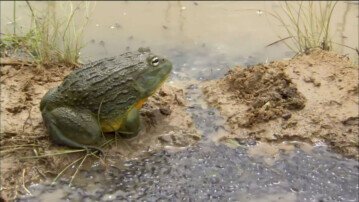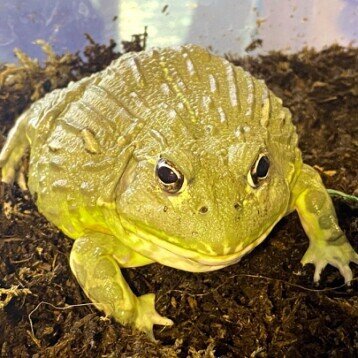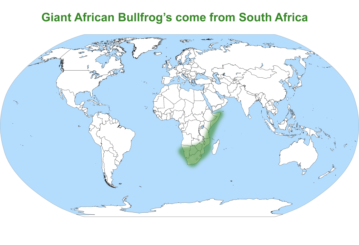African Bull Frog
Reptilarium Animals
African Bull Frog
Conservation status (Least Concern)


The African bullfrog (Pyxicephalus adspersus), also known as the Giant bullfrog or the South African Burrowing Frog, is a species of frog in the family Pyxicephalidae. It is also known as the pixie frog due to its scientific name. It is found in Angola, Botswana, Kenya, Malawi, Mozambique, Namibia, South Africa, Tanzania, Uganda, Zambia, Zimbabwe, and possibly the Democratic Republic of the Congo. It has been extirpated from Eswatini.
The natural habitat of the African bullfrog is moist to dry savanna, subtropical to tropical dry shrub-land, intermittent freshwater lakes, intermittent freshwater marshes, arable land, pastureland, canals, and flooded ditches. It is among the largest anurans on the planet, sixth only to the Goliath frog, the helmeted water toad, the Lake Junin frog, the Blyth's river frog, and the cane toad.
The males weigh up to 1.4 kg (3.1 lb) and grow to 24.5 cm (9.6 in) in snout–to–vent length. Females are half the size of males, which is unusual, considering that most female amphibians are (generally) larger than males, to help the amplexus.



The African bullfrog is a voracious carnivore, eating insects, other invertebrates, small rodents, reptiles, small birds, fish, and other amphibians.
It is also a cannibalistic species—the male African bullfrog is known for occasionally eating the tadpoles he guards.
An African bullfrog kept at the Pretoria Zoo in South Africa once ate 17 juvenile Rinkhals snakes (Hemachatus haemachatus).
They emit a loud croaking and a bleating sound when stressed or handled. It is one of the three frog species regularly kept in captivity that have sharp teeth and willingly bite humans when provoked or handled.
The African bullfrog males call out during the rainy season. The call lasts about a second and can be described as a low-pitched whoop.
Males have two breeding strategies, depending on their age.

